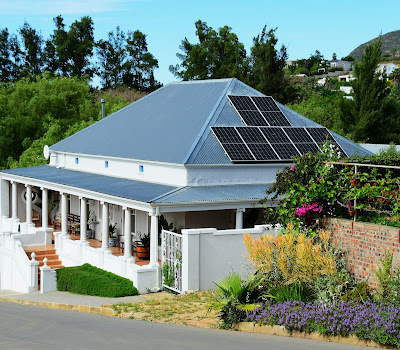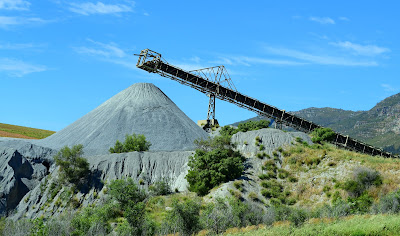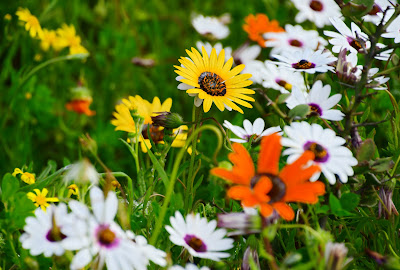 |
| Camps Bay Tidal Pool |
Summer is here - for those who don't like the waves, a tidal pool swim is the best experience!
Dip into one of these serene
swimming spots.
Blessed with views, a blue-water horizon over the
ocean and shoreline rock pools filled with colourful marine life, tidal pools
are always found in natural-beauty spots. Another drawcard is that the water is
calmer than the sea, and often warmer too, which is part of the reason why
you’ll find dedicated swimmers enjoying them all year round.
Time it right and you might have the pool all to yourself – a
serene, soul-stirring escape from daily life where you can hit “pause and
refresh”. At other times, tidal pools attract happy families because it’s a
place where kids can play freely and swim safely.
Whatever the situation, floating in a tidal pool or exploring
its underwater nooks with goggles and snorkel is surely one of the best ways to
spend your free time. So grab some suntan lotion, pack a picnic basket, and
make your way to one of these natural swimming pools.
St James Tidal Pool
Where St James, South Peninsula
Distance from CT 30 minutes
Cape Town’s most famous (and popular) tidal pool – it’s the one you’ll see on
the postcards, with its multicoloured changing huts. It’s below the railway
line near St James Station, tucked neatly between Muizenberg and Kalk Bay. On perfect-weather days it can be busy, so the
earlier you get here, the better.
Why we love it It has a wind-sheltered, family-friendly beach,
perfect for sunbathers and youngsters, though surfers ride the waves here too.
The iconic Victorian-style bathing huts add a bright splash of happy colour
that, along with the aqua waters and children playing in the sand, paints an
idyllic seaside-holiday scene like something out of an Enid Blyton novel.
Good to know The eye-catching “Meet the Locals” mural on the
railway wall was created by The Beach Co-op, an organisation advocating for
greener cleaning of the city’s tidal pools.
Where to find it Through the subway from St James Station, Main Road
(or along the catwalk from Surfer’s Corner, Muizenberg).
Miller’s Point
Tidal Pool
Where Simon’s Town, South Peninsula
Distance from CT 50 minutes
Just outside Simon’s Town, you’ll find Miller’s Point, which is divided into
two sections. The first turn-off leads to a caravan park and the Black Marlin
restaurant; the other leads to Rumbly Bay, where you’ll find two boat launch
sites and, in between them, this secluded tidal pool. Named after the man who
set up a whaling station here in 1825, today it is a popular whale-watching
site, as two deep pools out at sea to the north of it attract southern rights
and their calves.
Why we love it For its hidden location – unless you know it’s
there, you’ll miss it. There are incredible views across the rocky bay, a fun
waterslide into the pool and natural rock pools (ideal for kiddies to paddle
in), changing rooms and a grassed picnic and braai area. It’s also a great spot
for kayaking, snorkelling, surf skis and scuba-diving, with
popular dive sites (Partridge Point, Castle Rock and Smitswinkel) nearby.
Good to know Be careful when parking as there are crafty baboons in
the area – don’t approach or feed these sneaky rascals. No dogs allowed.
Cost An entry fee (R18 adults, R7 children) is charged on weekends
and during peak season.
Where to find it About 5km out of Simon’s Town on the M4; turn left
at the Cape Boat & Ski-Boat Club sign, and follow the road to the parking
area.
Glencairn Tidal
Pool
Where Glencairn, South Peninsula
Distance from CT 40 minutes
Just before Simon’s Town is Glencairn – a slightly longer and less
populated beach than nearby Fish Hoek. On the southern side, near the train
station, is a tidal pool where you can swim safely. Built in the 1920s, it was
refurbished and the walls almost completely rebuilt a few years ago. Just hop
across the railway line or head through the subway to reach it.
Why we love it A good portion of beach is enclosed within the walls
of the tidal pool, so there’s lovely golden sand to stretch out on. It’s also
quite a spacious pool – you can have a good and proper swim here. It’s also
surrounded by rocks with pools to explore at low tide. Glencairn Beach itself
is good for a dog-friendly stroll or jog, as is the revamped coastal walkway.
Where to find it Main Road (M4), Glencairn, 5km from Fish Hoek (or
4km from Simon’s Town in the opposite direction).
Maiden’s Cove Tidal
Pools
Where Camps Bay, Atlantic Seaboard
Distance from CT 20 minutes
Hidden among clumps of rocks, these two sheltered tidal pools offer spectacular
views of the mountains and ocean. Camps Bay is known for its buzzy restaurant
strip, and the prospect of taking a dip in these pools is yet another incentive
to visit.
Why we love it In addition boasting some of the best views you’re
likely to find from any poolside in Cape Town, and boulders for sunbathing on,
Maiden’s Cove has a stretch of beach and a grassy area for braais or picnics.
It’s a great family option, and one of the best spots to watch the sun dipping
into the Atlantic at the end of a beautiful day. It draws Instagrammers by the
dozen.
Where to find it Victoria Road, between Glen Beach and Clifton 4th.
Soetwater Tidal
Pool
Where Kommetjie, South Peninsula
Distance from CT 1 hour
This strip of wild coast in the shadow of the Slangkop Lighthouse, at the
most-southwestern end of the peninsula, was proclaimed a conservancy in 2009
due to its rich biodiversity. There’s also a dense kelp bed just offshore –
part of the giant kelp forests our shoreline is known for. The tidal pool, also
known as Infinity Pool, forms part of the facilities at the rustic Soetwater
Recreational Area.
Why we love it The unspoilt surroundings, made up of rocky
shoreline and kelp-strewn white beaches, affords visitors the chance to enjoy a
refreshing dip in a nature area – and fascinating beachcombing, rockpooling and
birdwatching (including endangered black oystercatchers). The pool, which has a
separate kiddies section, is adjacent to a braai area and picnic site.
Cost The entrance fee is R18 for adults, R7 for children. Day
visitor numbers are limited to 250, and no alcohol permitted.
Good to know Nearby De Kom tidal pool (corner of Beach Road and Van
Imhoff Way) is a great, free alternative at mid- and high tide (it empties out
a fair bit at low tide). It’s easy to access, with steps and a handrail, and
has a grassy area for picnics.
Where to find it Soetwater, Den Anker Road, off Lighthouse Road,
Kommetjie (via M65)
Wooley’s Tidal Pool
Where Kalk Bay, South Peninsula
Distance from CT 35 minutes
Wooley’s may not be big but it has its own merits. A smaller pool, tucked away
in the corner of the larger pool, provides a unique touch. Younger children can
paddle around in the shallower section, while more experienced swimmers take a
dip in the deep end.
Why we love it Wooley’s is easy to miss (on the road between Kalk
Bay and Clovelly), and thus provides a less crowded alternative to popular St
James. The flat rocks next to the pool are a nice spot to sit and admire the
view, but be careful traversing them as they’re slippery. Wooley’s is smaller
and more cloistered than its Kalk Bay siblings, so parents may feel more
confident about bringing younger children here, although note that there is no
beach and no facilities.
Where to find it Via a staircase (that goes under the railway line)
opposite 222 Main Road, Kalk Bay (via M4)
Saunders’ Rocks
Tidal Pool
Where Sea Point, Atlantic Seaboard
Distance from CT 20 minutes
Nestled into a rocky crevice on the Bantry Bay side of the Promenade, this
small, hexagonal tidal pool beckons like a diamond in the rough. Alongside a
lovely white-sand beach perfect for sunbathing, it’s a popular spot on weekends
but fairly quiet during the week.
Why we love it This pool is almost guaranteed to be wind-free,
thanks to the large granite rocks around it, which are the perfect perch for
watching the ships pass by. They’re also a popular launching platform for brave
folk to jump into the sea (note that there are rip currents, so it’s not safe
for swimming – hence the popularity of this pool). Go for a late-afternoon
dip, then enjoy a sunset picnic or dine out on the Sea Point strip.
Where to find it Beach Road, Sea Point
Camps Bay Tidal
Pool
Where Camps Bay, Atlantic Seaboard
Distance from CT 20 minutes
Camps Bay has a wide, sun-drenched beach, tantalising water and surfable waves,
but if you’re not looking for surf, head over to the beautiful tidal pool
(which is sometimes a little warmer than the sea). It’s very popular because
it’s so easy and convenient to access (paved, with stairs and a ramp), straight
off the main road.
Why we love it It’s one of the larger tidal pools, perfect for
swimming laps or an invigorating dip after a morning run or walk along the
beachfront, and it’s safe for the little ones to splash about in. It has a
strip of white sand, a lawn area, the quintessential boulders and rockpools of
this coastline, and views of the distant horizon. Being just off the main road,
restaurants and cafés are close by too.
Where to find it Victoria Road, just left of Camps Bay Beach on the
Bakoven side.
Dalebrook Tidal
Pool
Where Kalk Bay, South Peninsula
Distance from CT 30 minutes
Nestled between St James and Kalk Bay lies one of the most beautiful pools in
False Bay. To get to it, simply head through the subway under the railway line.
It’s best to get there in the morning, as it loses afternoon sun behind the mountains.
That said, as the early birds know, this east-facing pool is one of the best
places to be at sunrise, as it seamlessly melds into the ocean over the low
wall.
Why we love it The large boulders in the pool invite bathers to
make like mermaids contemplating the horizon… There’s a strong community spirit
here (the pool even has its own Facebook page) and it’s also a fabulous
whale-watching spot.
Good to know It has an outdoor shower and a changing room. Plus the
lovely folk at Dalebrook Cafe have made lockers available at the restaurant,
for swimmers to leave their valuables.
Where to find it Subway entrance across the road from Dalebrook
Cafe, 24 Main Road, Kalk Bay (via M4).
Buffels Bay Tidal
Pool
Where Cape Point Nature Reserve
Distance
from CT 1.5 hours
Even though it’s at heavily touristed Cape Point,
Buffels Bay is a relatively crowd-free beach. With breathtaking white sands,
clear blue water and green lawns, it’s worth seeking out for a beach day. The
area is abundant in flora and fauna, and you may even spot an antelope or
ostrich.
Why
we love it This part of the False Bay coast is protected and unspoilt,
which makes for a “wilder” swimming experience and incredible views. That said,
the neat little tidal pool is a safe option for children, and fabulous for a
post-hike dip. There are actually two pools here – there’s a second natural
rockpool right next to the manmade one. It’s an ideal setting for a picnic or
braai (although do watch out for baboons – don’t leave food lying around), and
on the other side of the pool is a slipway that’s handy for launching kayaks or
canoes.
Good
to know Around the headland from Buffels Bay (accessed via a separate
road) is Bordjiesrif, a popular fishing spot, also with a large tidal pool and
braai spots. From here, if you’re up for a walk, you can head to Venus Pool – a magnificent, aquarium-like natural rockpool filled
with sea life and great for snorkelling. The reserve’s gates open at 6am and
close at 6pm (7am to 5pm, April to September).
Contact 021 712 7471 / 021 712 0527
Where
to find it 20km from Simon’s Town on the M4; once in the reserve,
after passing the Buffelsfontein Visitors Centre, look for the left turn to
Buffels Bay.
Article Courtesy of The Inside Guide
https://insideguide.co.za/cape-town/tidal-pools/
For Accommodation Cape Town, South Africa




































